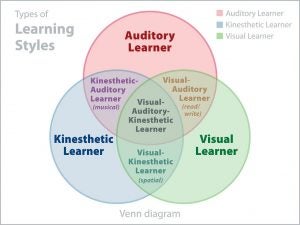Whether it’s Crop Science 101 or the Certified Crop Advisor Exam, we all have material we want to master. For all but a lucky few of us, there’s a big difference between memorizing information and actually learning it. Memorizing generally involves looking over flashcards many times so that you can recall the information briefly for a test. Unfortunately, after the test, we often forget much of what we just studied. This is because we’re simply trying to match one word we don’t know with its definition (i.e. more words). I’ll share with you some tips that have helped me get through lots of schooling over the years, and, even more importantly, how I retain the important knowledge that a farmer or colleague expects me to know.
An important first step is realizing that there are multiple ways in which people learn best. The graphic below does a good job of illustrating what many experts would agree are the main learning styles. For me, the style in which I learn best often depends on the subject. For math I’m visual, for mechanical reasoning I’m kinesthetic (hands on), and for more complex scientific topics I’m usually auditory.

To put these into a real-world example, let’s think about the nitrogen cycle. It’s something that almost all of us have probably at least heard of due to its importance in agriculture. But how many people could draw the entire cycle? Or name all of the processes? Here’s some advice for how to go about learning a relatively complex system without resorting to definitions on a flash card.
Auditory learners: If you like to have things explained out loud, you’re likely an auditory learner. This method is simpler than ever thanks to technology. YouTube and similar sites are excellent for finding lectures or presentations on almost any subject, including many agricultural disciplines. In addition, (with your professor’s permission) recording lectures with your laptop or voice recorder is a great strategy for auditory learners. You may also benefit from writing notes as you listen, or even making a goofy song. Silly as it may sound, replacing the introductory words to “Ice Ice Baby” with “Stop, immobilized by microbes,” may be a quirky key to (permanently) remembering that immobilization occurs when soil organisms tie up nutrients in their biomass.
Visual learners: Visual learners may benefit the most from figures and graphics. Many different nitrogen cycle diagrams can be found by simply doing an image search. Find the one that’s most visually appealing to you, and then re-draw it a few times! Once you can do it without looking at the original, there’s a good chance you’re well on your way to remembering the cycle. Videos and demonstrations are also excellent for visual learners. For example, it’s much, much easier for me to watch a video showing how to do an automotive repair than to read it in a service manual. Visual learners tend to be most receptive to color as well, so try utilizing color in your notes and drawings if possible.
Kinesthetic learners: Sometimes it can be difficult to relate abstract topics like the nitrogen cycle to something hands-on. Although we may not be able to actually feel mineralization happening with our bare hands, we can relate it to common tangible objects. Try thinking of the grit of table salt when picturing mineralization. If you can link that feeling in your mind to the fact that mineralization converts nutrients in organic matter into solid elements ready for plant uptake, it may increase your ability to recall it later.
The commonality between these styles is creating links between something you can easily remember — a melody, a color, a place (look up “memory palaces” if you’ve never heard of them), or how something feels — with the information you’re trying to remember. Since I’m somewhere in the middle, I like trying to combine all three. I take my Microsoft Surface to class, open OneNote (an Office program most of you probably have), and start recording the lecture right from the beginning. Then, I take notes on the screen using my own handwriting thanks to the Surface Pen. (Many studies have shown better memory recall when you write notes compared to typing them, which is why I also have a Samsung Galaxy Note 8. Handwriting is a powerful thing!) No Note and/or Surface? No problem! A pen and paper can work just as well assuming you write legibly and keep everything organized. I like digital notes since they’re searchable, but that’s just my preference. The most important part is to be taking good notes in the first place, so that studying will be much less painful down the road! I encourage everyone to look up more ways to improve your notetaking and studying, because one of the best skills you can have is being excellent at learning new material.
Spartan-state native Michael Swoish is a Michigan State alum who’s currently pursuing his Ph.D. in soil science at Virginia Tech. Michael has taught classes on precision agriculture and has traveled the country to get as much dirt time as possible.



